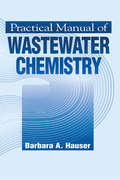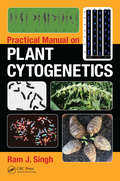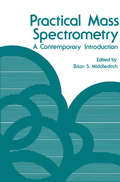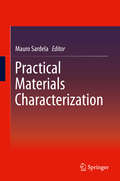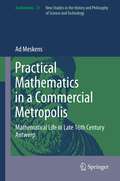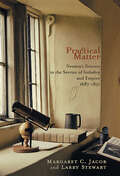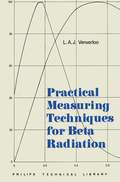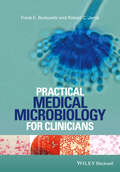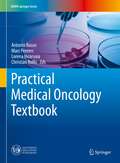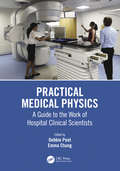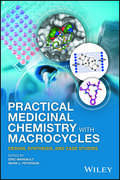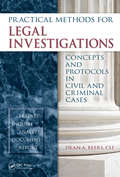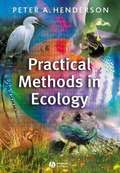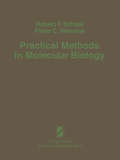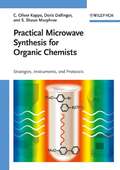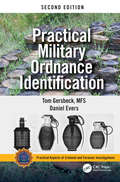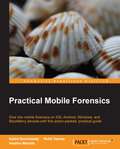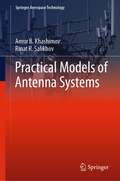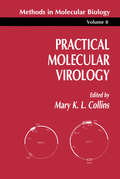- Table View
- List View
Practical Manual of Wastewater Chemistry
by Barbara HauserThis manual is prepared to enhance the wastewater treatment plant operator's understanding of laboratory theory and procedure in the testing of wastewater, to appreciate the nature of the contaminants under analysis, the analytical methods, and their limitations.
Practical Manual of Wastewater Chemistry
by Barbara HauserThis manual is prepared to enhance the wastewater treatment plant operator's understanding of laboratory theory and procedure in the testing of wastewater, to appreciate the nature of the contaminants under analysis, the analytical methods, and their limitations.
Practical Manual on Plant Cytogenetics
by Ram J. SinghEarlier books on the handling of plant chromosomes have not included many of the innovations in cytological techniques for many important crops that have become available in recent years, including information on associating genes with chromosomes. The aim of this book is to compile all the plant cytogenetic techniques, previously published in earlier books, into a laboratory manual. The first part of the book describes standard cytological techniques that are routinely used by students. The second part covers methods used for specific crops for which common cytological methods do not work satisfactorily. The third part discusses cytogenetic techniques (cytology and genetics) for physically locating genes on specific chromosomes. This novel book will be highly useful to students, teachers, and researchers as it is a convenient and comprehensive reference for all plant cytogenetic techniques and protocols.
Practical Manual on Plant Cytogenetics
by Ram J. SinghEarlier books on the handling of plant chromosomes have not included many of the innovations in cytological techniques for many important crops that have become available in recent years, including information on associating genes with chromosomes. The aim of this book is to compile all the plant cytogenetic techniques, previously published in earlier books, into a laboratory manual. The first part of the book describes standard cytological techniques that are routinely used by students. The second part covers methods used for specific crops for which common cytological methods do not work satisfactorily. The third part discusses cytogenetic techniques (cytology and genetics) for physically locating genes on specific chromosomes. This novel book will be highly useful to students, teachers, and researchers as it is a convenient and comprehensive reference for all plant cytogenetic techniques and protocols.
Practical Mass Spectrometry: A Contemporary Introduction
by Brian S. MiddleditchIt has been estimated that more than 8090 of the world's scientists who have ever lived are still alive today. It would not be unreasonable to suggest that more than 95% of those who have ever used a mass spectrometer are not only alive but are still actively employed. Most have never had any formal training in the subject since, with a few notable exceptions, universities have only recently begun to offer courses in mass spectrometry. We have written this book for the student of modern mass spectro metry: it is for the novice who wished to know what the instruments can do and how the techniques can be applied. There are other books on the market which delve into the history of mass spectrometry and go deeply into the mathematical theory and instrumentation. There are yet more books which guide one through the art of interpreting spectra. We have deliberately avoided these topics so that the reader is confronted only with the basic principles and is allowed a taste of the applications. One of the best methods of deVeloping a useful textbook is to teach a course based upon its content. This is what we did. We met in Houston in 1976 to teach a course on "Perspectives in Mass Spectrometry" and to coordinate our writing. The authors of five of the chapters met again in St.
Practical Materials Characterization
by Mauro SardelaPractical Materials Characterization covers the most common materials analysis techniques in a single volume. It stands as a quick reference for experienced users, as a learning tool for students, and as a guide for the understanding of typical data interpretation for anyone looking at results from a range of analytical techniques. The book includes analytical methods covering microstructural, surface, morphological, and optical characterization of materials with emphasis on microscopic structural, electronic, biological, and mechanical properties. Many examples in this volume cover cutting-edge technologies such as nanomaterials and life sciences.
Practical mathematics in a commercial metropolis: Mathematical life in late 16th century Antwerp (Archimedes #31)
by Ad MeskensDescribes the development and the ultimate demise of the practice of mathematics in sixteenth century Antwerp. Against the background of the violent history of the Religious Wars the story of the practice of mathematics in Antwerp is told through the lives of two protagonists Michiel Coignet and Peeter Heyns. The book touches on all aspects of practical mathematics from teaching and instrument making to the practice of building fortifications of the practice of navigation.
Practical Matter: Newton's Science in the Service of Industry and Empire, 1687-1851 (New Histories of Science, Technology, and Medicine)
by Margaret C. Jacob Larry StewartMargaret Jacob and Larry Stewart examine the profound transformation that began in 1687. From the year when Newton published his Principia to the Crystal Palace Exhibition of 1851, science gradually became central to Western thought and economic development. The book aims at a general audience and examines how, despite powerful opposition on the Continent, a Newtonian understanding gained acceptance and practical application. By the mid-eighteenth century the new science had achieved ascendancy, and the race was on to apply Newtonian mechanics to industry and manufacturing. They end the story with the temple to scientific and technological progress that was the Crystal Palace exhibition. Choosing their examples carefully, Jacob and Stewart show that there was nothing preordained or inevitable about the centrality awarded to science. "It is easy to forget that science might have been stillborn, or remained the esoteric knowledge of court elites. Instead, for better and for worse, science became a centerpiece of Western culture."
Practical Medical Microbiology for Clinicians
by Frank E. Berkowitz Robert C. JerrisInfectious diseases constitute a major portion of illnesses worldwide, and microbiology is a main pillar of clinical infectious disease practice. Knowledge of viruses, bacteria, fungi, and parasites is integral to practice in clinical infectious disease. Practical Medical Microbiology is an invaluable reference for medical microbiology instructors. Drs. Berkowitz and Jerris are experienced teachers in the fields of infectious diseases and microbiology respectively, and provide expert insight into microorganisms that affect patients, how organisms are related to each other, and how they are isolated and identified in the microbiology laboratory. The text also is designed to provide clinicians the knowledge they need to facilitate communication with the microbiologist in their laboratory. The text takes a systematic approach to medical microbiology, describing taxonomy of human pathogens and consideration of organisms within specific taxonomic groups. The text tackles main clinical infections caused by different organisms, and supplements these descriptions with clinical case studies, in order to demonstrate the effects of various organisms. Practical Medical Microbiology is an invaluable resource for students, teachers, and researchers studying clinical microbiology, medical microbiology, infectious diseases, and virology.
Practical Medical Microbiology for Clinicians
by Frank E. Berkowitz Robert C. JerrisInfectious diseases constitute a major portion of illnesses worldwide, and microbiology is a main pillar of clinical infectious disease practice. Knowledge of viruses, bacteria, fungi, and parasites is integral to practice in clinical infectious disease. Practical Medical Microbiology is an invaluable reference for medical microbiology instructors. Drs. Berkowitz and Jerris are experienced teachers in the fields of infectious diseases and microbiology respectively, and provide expert insight into microorganisms that affect patients, how organisms are related to each other, and how they are isolated and identified in the microbiology laboratory. The text also is designed to provide clinicians the knowledge they need to facilitate communication with the microbiologist in their laboratory. The text takes a systematic approach to medical microbiology, describing taxonomy of human pathogens and consideration of organisms within specific taxonomic groups. The text tackles main clinical infections caused by different organisms, and supplements these descriptions with clinical case studies, in order to demonstrate the effects of various organisms. Practical Medical Microbiology is an invaluable resource for students, teachers, and researchers studying clinical microbiology, medical microbiology, infectious diseases, and virology.
Practical Medical Oncology Textbook (UNIPA Springer Series)
by Antonio Russo Christian Rolfo Marc Peeters Lorena IncorvaiaThis textbook combines essential information on clinical cancer medicine with a guide to the latest advances in molecular oncology and tumor biology. Providing a systematic overview of all types of solid tumors, including epidemiology and cancer prevention, genetic aspects of hereditary cancers, differential diagnosis, typical signs and symptoms, diagnostic strategies and staging, and treatment modalities, it also discusses new and innovative cancer treatments, particularly targeted therapy and immunotherapy. Expert commentaries at the end of each chapter highlight key points, offer insights, suggest further reading and discuss clinical application using case descriptions. This textbook is an invaluable, practice-oriented tool for medical students just beginning their clinical oncology studies, as well as for medical oncology residents and young professionals.
Practical Medical Physics: A Guide to the Work of Hospital Clinical Scientists
by Debbie PeetThis is the first all-encompassing textbook designed to support trainee clinical scientists in medical physics as they start work in a hospital setting whilst undertaking an academic master’s course. Developed by practising physicists and experienced academics using their experience of teaching trainee medical physicists, this book provides an accessible introduction to the daily tasks that clinical scientists perform in the course of their work. It bridges the gap between theory and practice, making the book also suitable for advanced undergraduate and graduate students in other disciplines studying modules on medical physics, including those who are considering a career in medical physics through applying to the NHS Scientist Training Programme (STP). Features: Provides an accessible introduction to practical medical physics within a hospital environment Maps to the course content of the Scientist Training Programme in the NHS Acts as a complement to the academic books often recommended for medical physics courses
Practical Medical Physics: A Guide to the Work of Hospital Clinical Scientists
by Debbie Peet Emma ChungThis is the first all-encompassing textbook designed to support trainee clinical scientists in medical physics as they start work in a hospital setting whilst undertaking an academic master’s course. Developed by practising physicists and experienced academics using their experience of teaching trainee medical physicists, this book provides an accessible introduction to the daily tasks that clinical scientists perform in the course of their work. It bridges the gap between theory and practice, making the book also suitable for advanced undergraduate and graduate students in other disciplines studying modules on medical physics, including those who are considering a career in medical physics through applying to the NHS Scientist Training Programme (STP). Features: Provides an accessible introduction to practical medical physics within a hospital environment Maps to the course content of the Scientist Training Programme in the NHS Acts as a complement to the academic books often recommended for medical physics courses
Practical Medicinal Chemistry with Macrocycles: Design, Synthesis, and Case Studies
by Eric Marsault Mark L. PetersonIncluding case studies of macrocyclic marketed drugs and macrocycles in drug development, this book helps medicinal chemists deal with the synthetic and conceptual challenges of macrocycles in drug discovery efforts. Provides needed background to build a program in macrocycle drug discovery –design criteria, macrocycle profiles, applications, and limitations Features chapters contributed from leading international figures involved in macrocyclic drug discovery efforts Covers design criteria, typical profile of current macrocycles, applications, and limitations
Practical Medicinal Chemistry with Macrocycles: Design, Synthesis, and Case Studies
by Eric Marsault Mark L. PetersonIncluding case studies of macrocyclic marketed drugs and macrocycles in drug development, this book helps medicinal chemists deal with the synthetic and conceptual challenges of macrocycles in drug discovery efforts. Provides needed background to build a program in macrocycle drug discovery –design criteria, macrocycle profiles, applications, and limitations Features chapters contributed from leading international figures involved in macrocyclic drug discovery efforts Covers design criteria, typical profile of current macrocycles, applications, and limitations
Practical Methods for Legal Investigations: Concepts and Protocols in Civil and Criminal Cases
by CLI, Dean BeersLegal investigators are responsible for providing factual evidence � as the fact finders, they are the foundation for the attorneys they work with daily. The attorney is responsible for forming and implementing the legal strategy and presenting it to the judge or jury. The legal investigator provides checks and balances to ensure that no evidence i
Practical Methods in Ecology
by Peter A. HendersonThere are few books available that provide a good introduction to the methods and techniques for ecological research. This book will be invaluable to lecturers teaching field courses and students undertaking project work in ecology. Each chapter will focus on an ecological technique. It will have an introductory section that describes the ecological principles and theory. This will then be followed by example applications. These will focus on three most common habitats where teachers take students for fieldwork; the seashore, ponds and lakes, fields and woodland. Gives specific worked examples from the main ecosystems used for undergraduate study - seashore, lakes/ponds, field and woodland. Only introductory text specifically focused on field techniques. Great 'how-to' guide that will show student exactly how to carry out each method. Only text to emphasise the principles behind the techniques - taking a methods based approach rather than a taxonomic approach (eg chapters split into population measures, biodiversity measures, species richness measures rather than methods for invertebrates, methods for mammals, methods for birds etc). Greater emphasis on the equipment involved - how to make it, where to buy it. Good references to further reading and advanced techniques.
Practical Methods in Molecular Biology
by Robert F. Schleif Pieter C. WensinkThis volume has evolved from a laboratory methods book that one of us first compiled nearly fifteen years ago. Since that time the book has undergone many minor revisions in order to include new methods and updated versions of older methods. The result has been an increasingly useful and more widely circulated book. However, the recent series of technological explosions generally lumped together under the name of "recombinant DNA technology" has been a turning point in the evolution of this previously underground publication. Minor revisions will no longer do. To keep the book useful we have had to make major revi sions and additions. The result is a dramatically expanded book that should be more useful to more people. The larger size and wider usefulness of the book have made this more formal publication seem a reasonable step to take. One of the reasons that this volume should be useful to many people is that it includes only procedures that have been used repeatedly by us and that have proven highly reliable both to ourselves and to others in our laboratories.
Practical Microwave Synthesis for Organic Chemists: Strategies, Instruments, and Protocols
by C. Oliver Kappe Doris Dallinger Shaun S. MurphreeWith the novice user in mind, this beginner's guide explains the basics behind microwave technology, evaluates available instruments and reaction modes, and provides practical hints for every eventuality. Includes 27 detailed protocols for often-used reactions. From the contents: 1 Microwave Synthesis - An Introduction 2 Microwave Theory 3 Equipment Review 4 Microwave Processing Techniques 5 Starting With Microwave Chemistry 6 Experimental Protocols 6.1 General Small-Scale Sealed-Vessel Microwave Processing 6.2 Reaction Optimization 6.3 Library Generation 6.4 Reaction Scale-Up 6.5 Special Processing Techniques
Practical Military Ordnance Identification, Second Edition (Practical Aspects of Criminal and Forensic Investigations)
by Thomas GersbeckThe threat variables associated with military ordnance are enormous, requiring the application of a structured process to identify unknown munitions. The focus of Practical Military Ordnance Identification, Second Edition is the application of a practical deductive process to identify unknown ordnance items that are commonly recovered outside military control. The author supplies a seven-step procedure to identify unknown munitions by their category, group, and type. Detailed logic trees help users narrow down the possibilities in order to accurately identify ordnance. The book covers the safety precautions associated with each category and group of ordnance. It describes many ordnance construction characteristics and explains the fundamentals of military ordnance fuzing. Appendices define terms and supply abbreviations and acronyms used to describe military ordnances. Coverage new to this edition include: a list of conventional markings; additional safety precautions to take; an expanded list of high explosives; additional technical details on explosives effects; hazards associated with pyrotechnics, pyrophorics, smoke compounds, and incendiaries; a section on pre-1870 projectiles, hand grenades, landmines, underwater ordnances, and rockets; and details on Man-Portable-Air-Defense-Systems (MANPADS) missile systems.
Practical Military Ordnance Identification, Second Edition (Practical Aspects of Criminal and Forensic Investigations #59)
by Thomas GersbeckThe threat variables associated with military ordnance are enormous, requiring the application of a structured process to identify unknown munitions. The focus of Practical Military Ordnance Identification, Second Edition is the application of a practical deductive process to identify unknown ordnance items that are commonly recovered outside military control. The author supplies a seven-step procedure to identify unknown munitions by their category, group, and type. Detailed logic trees help users narrow down the possibilities in order to accurately identify ordnance. The book covers the safety precautions associated with each category and group of ordnance. It describes many ordnance construction characteristics and explains the fundamentals of military ordnance fuzing. Appendices define terms and supply abbreviations and acronyms used to describe military ordnances. Coverage new to this edition include: a list of conventional markings; additional safety precautions to take; an expanded list of high explosives; additional technical details on explosives effects; hazards associated with pyrotechnics, pyrophorics, smoke compounds, and incendiaries; a section on pre-1870 projectiles, hand grenades, landmines, underwater ordnances, and rockets; and details on Man-Portable-Air-Defense-Systems (MANPADS) missile systems.
Practical Mobile Forensics
by Satish Bommisetty Rohit Tamma Heather MahalikThe book is an easy-to-follow guide with clear instructions on various mobile forensic techniques. The chapters and the topics within are structured for a smooth learning curve, which will swiftly empower you to master mobile forensics. If you are a budding forensic analyst, consultant, engineer, or a forensic professional wanting to expand your skillset, this is the book for you. The book will also be beneficial to those with an interest in mobile forensics or wanting to find data lost on mobile devices. It will be helpful to be familiar with forensics in general but no prior experience is required to follow this book.
Practical Models of Antenna Systems (Springer Aerospace Technology)
by Amur B. Khashimov Rinat R. SalikhovThis book discusses the principles of forming and analysis of mathematical models of a wide class of antenna systems, new scientific directions in the development and application of computational algorithms for the study of mathematical models for antenna arrays of radio navigating systems. The book is presented for specialists in antenna system design; it may be useful for students of radio engineering specialties. This book consequentially uses the asymptotic correspondence of two-dimensional and three-dimensional problems to antenna engineering, that includes the influence of the placement objects for a given limited class of problems. Rigorous electrodynamics formulations of models and the use of efficient numerical methods provide the reliability and accuracy of modeling.
